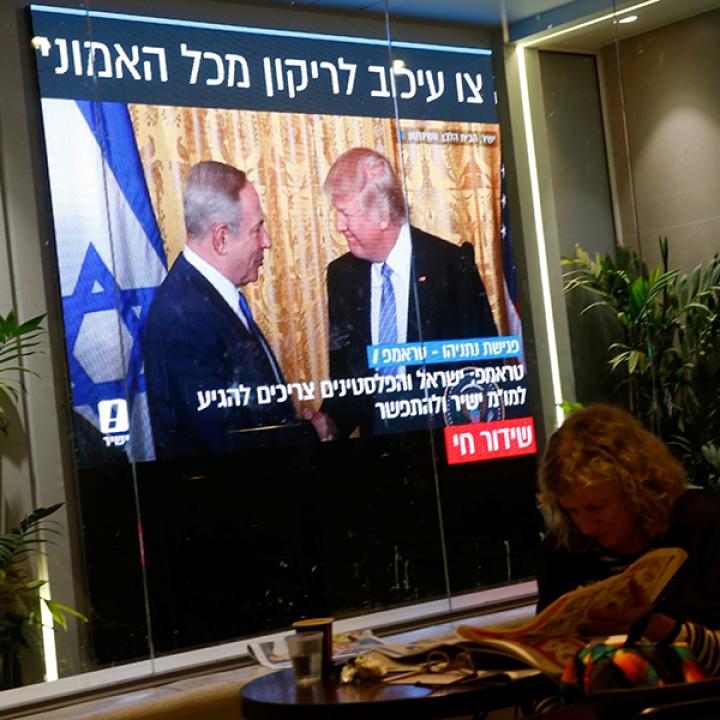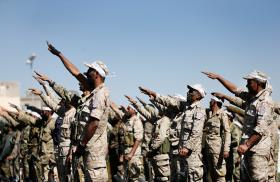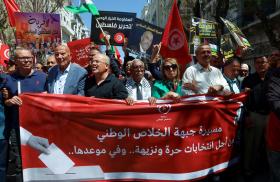
- Policy Analysis
- PolicyWatch 3984
Opening the Floodgates: The Gaza Deal and Trump’s Presidency

The ceasefire is already shaking up Israel’s politics and high command; prompt, well-coordinated action with Washington could help counter threats on several external fronts as well.
Two events in the past week—the Gaza ceasefire agreement and President Trump’s inauguration—may herald a flood that removes logjams and catalyzes a strategic reset in Israel and the Middle East. To realize this potential, U.S. and Israel officials will need to collaborate on proactive policy initiatives regarding Gaza, Iran, Saudi Arabia, and the Israeli-Palestinian conflict.
If the ceasefire holds, it could end the bloody chapter that began on October 7 and usher in a new phase pregnant with opportunities, disappointments, and risks. Joy over the release of hostages awaits, alongside mourning over the dead and anger over the implications of releasing terrorists as part of the prisoner exchange.
Yet significant challenges—especially in Israeli politics—may undermine the ceasefire and impede its next phases, as Prime Minister Binyamin Netanyahu attempts to balance between ending the war and ensuring the survival of his coalition government. Trump’s pressure is what tipped Netanyahu toward signing the agreement, and continued U.S. pressure will be needed if the deal is to advance vital interests shared by Washington, Jerusalem, and other regional partners.
Cascading Effects on Seven Fronts
Since the October 7 attack, Israel has fought a war on seven fronts, achieving significant military gains. The ceasefire may mark the end of that war, though remaining threats on each front—as well as complications on the domestic “front”—demand follow-on efforts to transform these gains into sustainable strategic achievements.
Gaza. The ceasefire immediately reduced the fighting in Gaza and will soon decrease the Israeli troop presence there as well. Despite losing much of its fighting force and military capabilities, however, Hamas retains significant guerrilla, rocket, and tunnel capabilities. It has also leveraged control over local distribution of humanitarian aid to continue ruling much of the Strip, recruiting new fighters, and rebuilding itself in preparation for the future conflicts that Hamas leaders swore to wage mere hours after signing the deal. Hence, Israel’s war objective of destroying the group’s governance capabilities remains unfulfilled.
Negotiations are soon expected to unfold regarding the terms of the ceasefire’s second phase, including the exchange of all remaining hostages for more—and worse—Palestinian prisoners and a wider Israel Defense Forces (IDF) withdrawal. The deal will also compel the Israeli government to finally explore alternatives to Hamas governance that do not involve Israeli control, and that go beyond just curbing the group’s rearmament through the Egyptian border and other crossings. This entails shaping international plans for Gaza’s reconstruction and demilitarization while formulating security arrangements following IDF withdrawals.
As these efforts unfold, the war’s devastation will dominate Gaza’s landscape for years, and the high Palestinian death toll will likely fuel further legal and diplomatic actions against Israel. Increased media access to Gaza and recovery of bodies in the rubble will only increase these pressures.
The West Bank. A combination of a weakening Palestinian Authority, increasing Palestinian terrorism, aggressive Israeli countermeasures, and lenient law enforcement against violent crimes by Jewish extremists has created a highly combustible situation in the West Bank. Hamas will no doubt seek to worsen this situation in the near term, exploiting the release of its prisoners to further undermine PA rule and escalate attacks against Israel. The continued flow of arms and funds through Jordan exacerbates these threats.
Even as it approved the ceasefire in Gaza, the Israeli government added a new war goal: to severely degrade terrorist organizations in the West Bank. Toward this end, it reinforced the IDF presence on that front after units completed their missions in Gaza. On January 21, the IDF began a new offensive in Jenin—“Operation Iron Wall”—and erected massive roadblocks across the West Bank. Concurrently, groups of Israeli civilians conducted violent rampages in the Palestinian villages of al-Funduq, Sinjil, and Turmus Aya, setting fire to cars and houses and attacking locals. Some of these attackers were shot by Israeli police.
Lebanon. Hezbollah has suffered major losses, accepted a humiliating ceasefire, and now faces a new president and prime minister who may threaten its interests. Despite these positive developments, however, formidable challenges remain, from disarming the group and demilitarizing southern Lebanon to ensuring the safe return of residents in northern Israel.
Syria. The collapse of the Assad regime is a blow to Iran’s “axis of resistance” and Hezbollah’s rearmament efforts. Yet it also carries the risk of chaos, an Islamic State resurgence, and/or the creation of an Islamist regime backed by Turkey. Moreover, Iran’s efforts to reassert its influence and other threats will intensify if the Trump administration decides to withdraw U.S. troops.
Iran. The regime has been weakened by direct strikes inside Iran and the loss of strategic depth in Syria and Lebanon. Tehran now stands at a crucial crossroads—between pursuing nuclear weapons or accepting a new deal, and between rethinking its proxy enterprise or doubling down on restoring its sway in the Fertile Crescent.
Iraq. Iran-backed Shia militias in Iraq have ceased attacks on Israel for fear of retaliation, amid ongoing discussions about (and threats against) the U.S. presence there.
Yemen. When the Gaza deal was signed, the Houthis announced that they would stop attacking non-Israeli vessels in the Red Sea area immediately and halt attacks on Israeli ships more gradually, “upon the full implementation of all phases of the agreement.” Yet their willingness to make good on this pledge is uncertain, and they reserved the option to widen their campaign again if fighting resumes in Gaza or the West Bank. (These developments will be discussed in greater detail in a forthcoming PolicyWatch.) More broadly, the group has been emboldened by the international attention and revenue it has received over the past year and a half and remains a significant threat to Israel, U.S. forces, regional stability, and maritime security.
The Eighth Front Is Domestic
For over a year, the October 7 crisis held up a slew of vital political and legal processes inside Israel. The government repeatedly used the state of war to justify suppressing protests, ignoring public demands for a commission of inquiry, and dismissing calls for early elections and the resignation of those responsible for the catastrophe. The war was also used as a pretext to delay Netanyahu’s criminal trial, potentially giving the prime minister a personal interest in perpetuating the conflict.
When the ceasefire terms were announced last week—reportedly identical to President Biden’s proposal from May—pressure from Trump was the wild card that made Netanyahu willing to brave secession threats from his coalition partners and accept the deal. Predictably, the removal of the wartime logjam opened the floodgates of domestic action.
Immediately after the ceasefire, the party of National Security Minister Itamar Ben-Gvir resigned from the government, while Finance Minister Bezalel Smotrich threatened to step down if the deal’s second phase is approved. Because the departure of far-right parties could bring down Netanyahu’s coalition, the prime minister will have strong incentive to take actions that appease his partners but potentially threaten the ceasefire. For example, his quick approval of more aggressive military operations in the West Bank—Smotrich’s top priority—was a timely response to rising threats there.
Elsewhere, IDF chief of staff Gen. Herzi Halevi announced his resignation on January 21, two days after the ceasefire. He was followed by the head of Southern Command, and more generals will surely look for the exit door soon. The government is also expected to press the head of the Israel Security Agency to resign, centralizing more powers under Netanyahu’s hand and potentially increasing public calls for similar moves at the political level.
Meanwhile, Israeli sentiment is already shifting amid the return of hostages and bodies, the cessation of hostilities, and images of released terrorists. This could ignite protests for and against the deal, as well as louder demands for a state inquiry and calls for early elections.
Policy Implications
Coming at the start of Trump’s presidency, the Gaza ceasefire could serve as the first success of his “peace through strength” doctrine and appeal to his aspirations as a peacemaker. In particular, the decline in fighting may enable Washington and Jerusalem to focus on larger strategic issues such as countering Iran’s nuclear program and expanding the Abraham Accords to include Saudi Arabia. Progress on these issues could bring a dramatic shift in the strategic landscape—though they require changes in Israel’s Palestinian policy, which seem improbable under the current government.
In any case, officials should focus on the following steps in the near term:
- Free all hostages and end the war. Israel should work with the United States and other partners to fully implement the ceasefire’s first phase and quickly negotiate the terms of subsequent phases to expedite the release of all hostages and fully end the war. At the same time, they should prepare alternative plans in case the fragile ceasefire collapses and fighting resumes—though Washington would be wise to do whatever it can to ensure that Israel’s domestic politics are not the cause of this collapse.
- End Hamas rule in Gaza. Israel and its partners should take steps to curtail Hamas control on the ground and prevent the group from resurging and rearming. This entails a combination of military, diplomatic, economic, and informational efforts. Effective, moderate governance should be promoted, and reconstruction must be conditioned on demilitarization.
- Prevent Iran from going nuclear and defeat its axis. Israel should work with the United States to craft a joint strategy on ensuring that Iran never acquires nuclear weapons. This effort should combine the following: a renewed “maximum pressure” economic campaign; credible military options (Israeli, American, or joint), which may well be employed; and a strong agreement that rolls Iran back from the nuclear threshold. Israel and the United States should also partner with neighboring states to prevent the recovery of Iran’s “axis of resistance” and neutralize any continuing threats posed by proxies in Yemen and Iraq.
- Expand Arab-Israel peace. Officials should seek new diplomatic breakthroughs in the region, from establishing formal relations between Israel and Saudi Arabia to announcing a political horizon for the Palestinians and advancing the conditions needed for a successful peace process in the future.
- Stabilize the Levant. Joint efforts are needed to prevent Hezbollah’s recovery, stabilize the Lebanon ceasefire, address emerging threats from Syria and Turkey, and safeguard Jordan’s stability.
Brig. Gen. Assaf Orion (Res.) is The Washington Institute’s Rueven International Fellow and former head of the IDF Strategic Planning Division.



